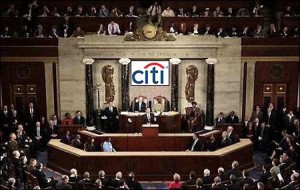
Citigroup is the Wall Street mega bank that forced the repeal of the Glass-Steagall Act in 1999; blew itself up as a result of the repeal in 2008; was propped back up with the largest taxpayer bailout in the history of the world even though it was insolvent and didn’t qualify for a bailout; has now written its own legislation to de-regulate itself; got the President of the United States to lobby for its passage; and received an up vote from both houses of Congress in less than a week.
And there is one more thing you should know at the outset about Citigroup: it didn’t just have a hand in bringing the country to its knees in 2008; it was a key participant in the 1929 collapse under the moniker National City Bank. Both the U.S. Senate’s investigation of the collapse of the financial system in 1929 and the Financial Crisis Inquiry Commission (FCIC) that investigated the 2008 collapse cited this bank as a key culprit.
The FCIC wrote:
“…we do not accept the view that
regulators lacked the power to protect the financial system. They had
ample power in many arenas and they chose not to use it. To give just
three examples: the Securities and Exchange Commission could have
required more capital and halted risky practices at the big investment
banks. It did not. The Federal Reserve Bank of New York and other
regulators could have clamped down on Citigroup’s excesses in the run-up
to the crisis. They did not. Policy makers and regulators could have
stopped the runaway mortgage securitization train. They did not…Too
often, they lacked the political will – in a political and ideological
environment that constrained it – as well as the fortitude to critically
challenge the institutions and the entire system they were entrusted to
oversee.”
